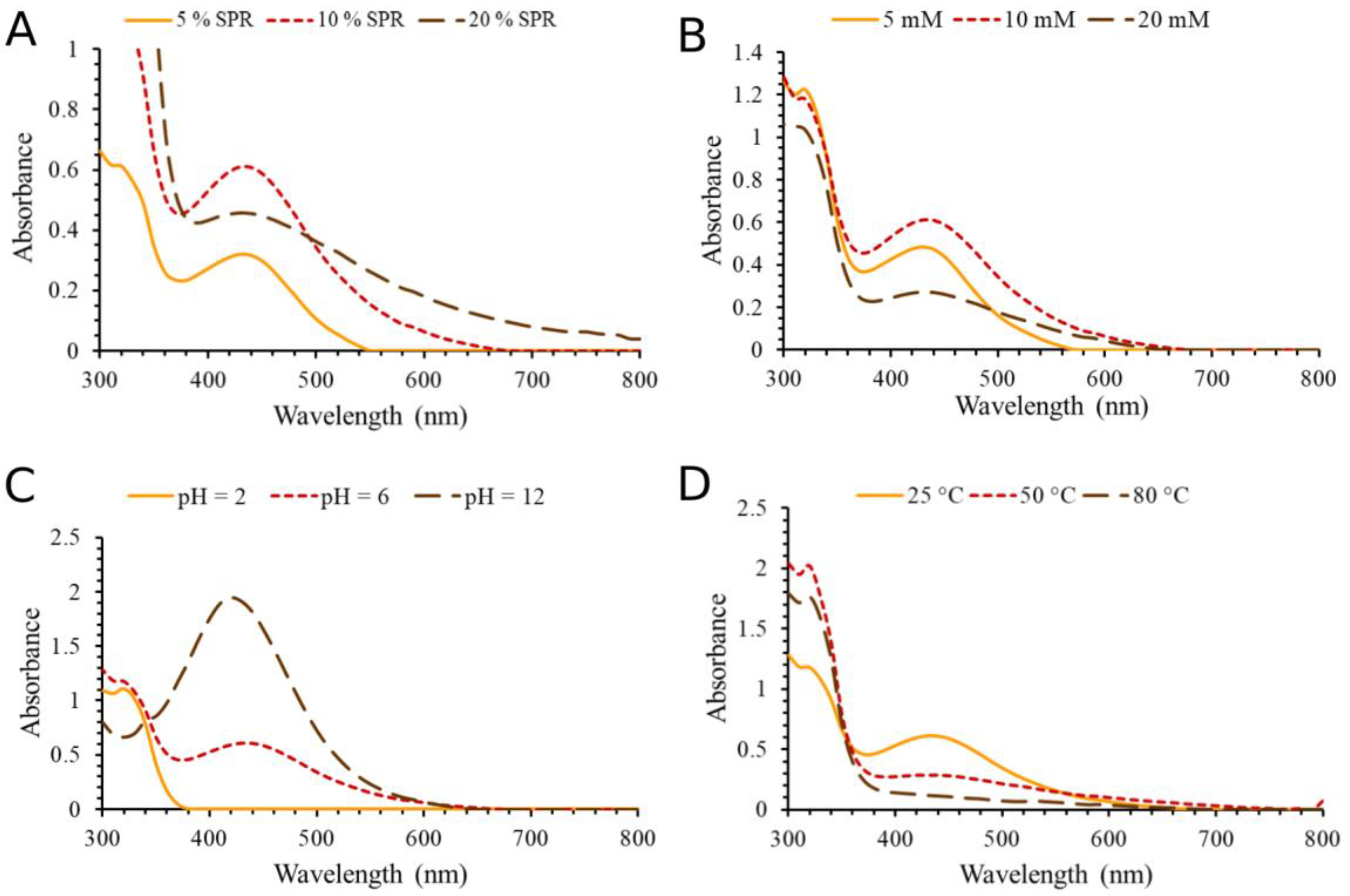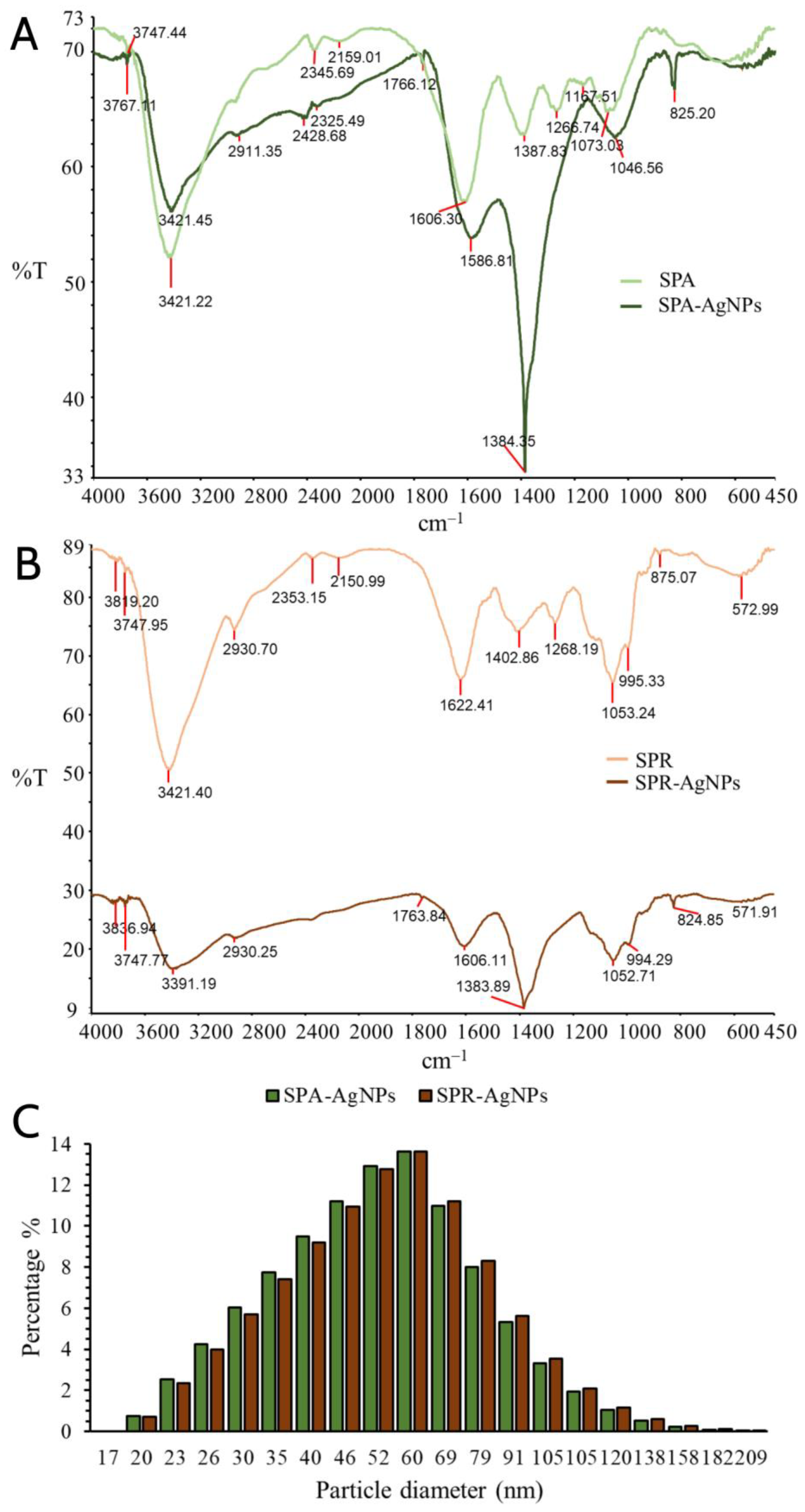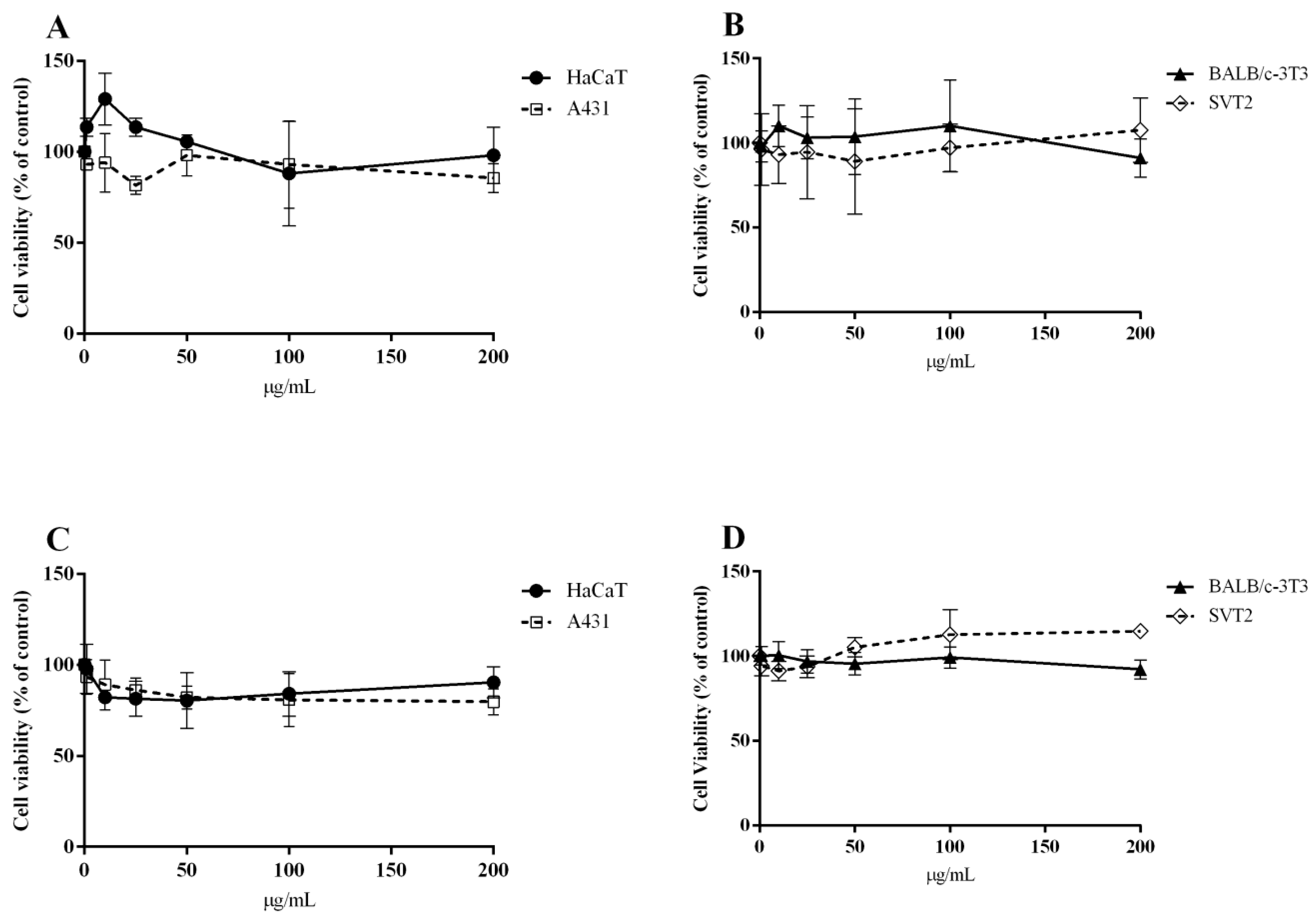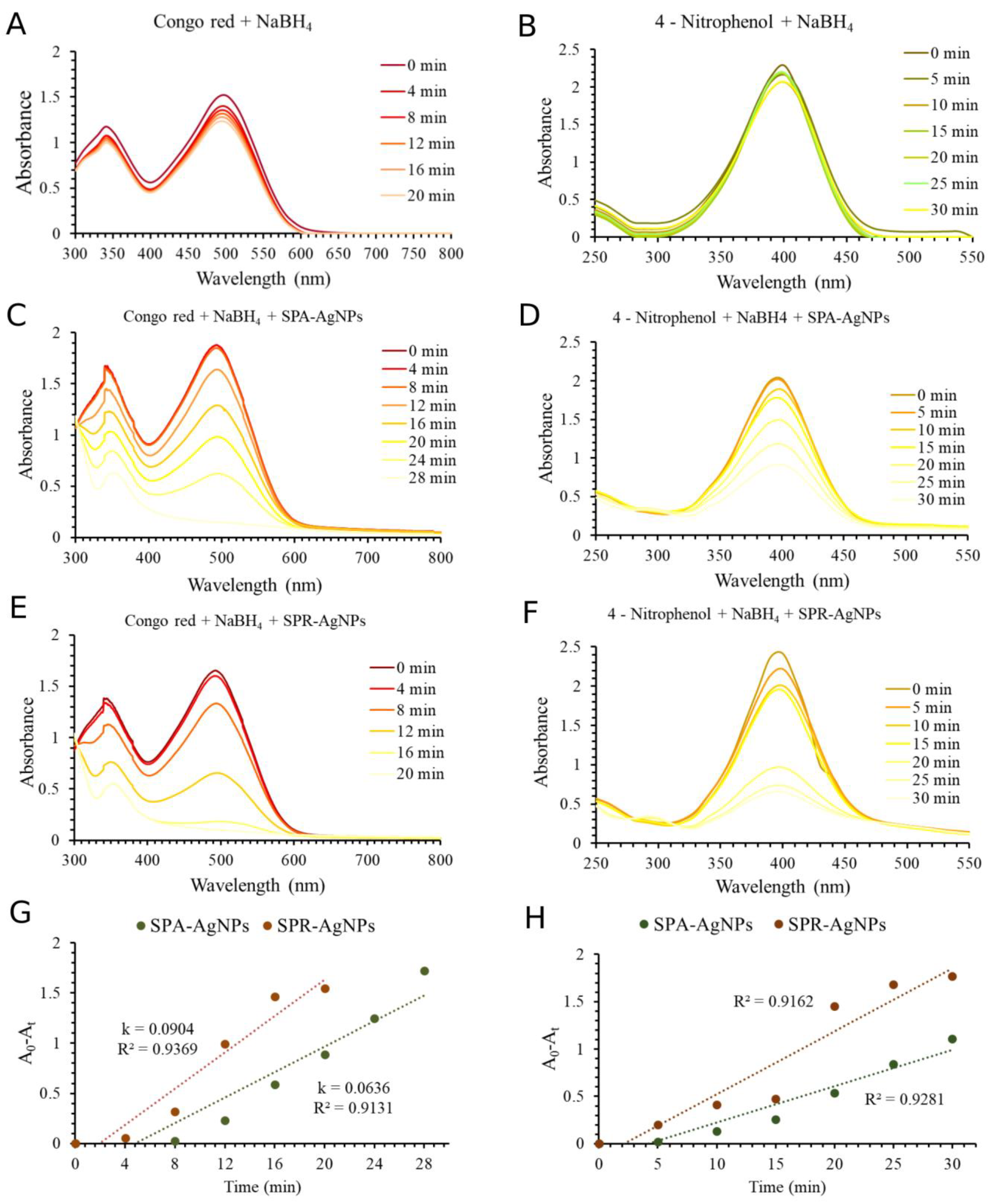Biosynthesis of Silver Nanoparticles Using Salvia pratensis L. Aerial Part and Root Extracts: Bioactivity, Biocompatibility, and Catalytic Potential
Abstract
:1. Introduction
2. Results and Discussion
2.1. Optimization Conditions and Synthesis of Silver Nanoparticles
2.2. Characterization of the Obtained AgNPs
2.2.1. XRPD Analysis
2.2.2. SEM/EDS Analysis
2.2.3. FTIR Spectroscopy
2.2.4. DLS Analysis
2.3. Phenolic Profile of S. pratensis Extracts and Antioxidant Activity of Extracts and Synthesized AgNPs
2.4. Antimicrobial Potential of Synthesized Silver Nanoparticles
2.5. Biocompatibility of SPA-AgNPs and SPR-AgNPs
2.6. Hemolytic Activity of SPA-AgNPs and SPR-AgNPs
2.7. Catalytic Application of Nanoparticles
3. Materials and Methods
3.1. Extraction Process of S. pratensis
3.2. Total Content of Phenolic and Flavonoid Compounds in the Extracts
3.3. Synthesis of Silver Nanoparticles and Optimization Conditions
3.4. Characterization
3.5. Antioxidant Activity
3.6. Antimicrobial Activity
3.7. Hemolytic Activity
3.8. Biocompatibility and Cytotoxicity Analyses
3.9. Catalytic Application of Nanoparticles during Congo Red and 4-Nitrophenol Degradation
4. Conclusions
Supplementary Materials
Author Contributions
Funding
Institutional Review Board Statement
Informed Consent Statement
Data Availability Statement
Conflicts of Interest
Sample Availability
References
- Iravani, S. Green Synthesis of Metal Nanoparticles Using Plants. Green Chem. 2011, 13, 2638–2650. [Google Scholar] [CrossRef]
- Srećković, N.Z.; Nedić, Z.P.; Liberti, D.; Monti, D.M.; Mihailović, N.R.; Katanić Stanković, J.S.; Dimitrijević, S.; Mihailović, V.B. Application Potential of Biogenically Synthesized Silver Nanoparticles Using: Lythrum Salicaria L. Extracts as Pharmaceuticals and Catalysts for Organic Pollutant Degradation. RSC Adv. 2021, 11, 35585–35599. [Google Scholar] [CrossRef] [PubMed]
- Rajan, R.; Chandran, K.; Harper, S.L.; Yun, S.I.; Kalaichelvan, P.T. Plant Extract Synthesized Silver Nanoparticles: An Ongoing Source of Novel Biocompatible Materials. Ind. Crops Prod. 2015, 70, 356–373. [Google Scholar] [CrossRef]
- Shemetov, A.A.; Nabiev, I.; Sukhanova, A. Molecular Interaction of Proteins and Peptides with Nanoparticles. ACS Nano 2012, 6, 4585–4602. [Google Scholar] [CrossRef] [PubMed]
- Gupta, S.; Kumar Tejavath, K.; Kumar Tejavath Kirankumar, K. Phytosynthesized Nanoparticle-Directed Catalytic Reduction of Synthetic Dyes: Beast to Beauty Abbreviations 2,4-DNPH 2,4-Dinitrophenylhydrazine 2-NP 2-Nitrophenol 3-NP 3-Nitrophenol 4-NP 4-Nitrophenol CBB Coomassie Brilliant Blue. Nanotechnol. Environ. Eng. 2021, 6, 6. [Google Scholar] [CrossRef]
- Rehman, A.; Nisa, M.U.; Usman, M.; Ahmad, Z.; Bokhari, T.H.; Rahman, H.M.A.U.; Rasheed, A.; Kiran, L. Application of Cationic-Nonionic Surfactant Based Nanostructured Dye Carriers: Mixed Micellar Solubilization. J. Mol. Liq. 2021, 326, 115345. [Google Scholar] [CrossRef]
- Amjad, S.; Shaukat, S.; Rahman, H.M.A.U.; Usman, M.; Farooqi, Z.H.; Nazar, M.F. Application of Anionic-Nonionic Mixed Micellar System for Solubilization of Methylene Blue Dye. J. Mol. Liq. 2023, 369, 120958. [Google Scholar] [CrossRef]
- Balzarro, M.; Rubilotta, E.; Trabacchin, N.; Soldano, A.; Cerrato, C.; Migliorini, F.; Mancini, V.; Pastore, A.L.; Carbone, A.; Cormio, L.; et al. Clinical Medicine Early and Late Efficacy on Wound Healing of Silver Nanoparticle Gel in Males after Circumcision. J. Clin. Med. 2020, 9, 1822. [Google Scholar] [CrossRef]
- Yin, I.X.; Zhang, J.; Zhao, I.S.; Mei, M.L.; Li, Q.; Chu, C.H. The Antibacterial Mechanism of Silver Nanoparticles and Its Application in Dentistry. Int. J. Nanomed. 2020, 2020, 2555–2562. [Google Scholar] [CrossRef]
- Metwally, D.M.; Alajmi, R.A.; El-Khadragy, M.F.; Al-Quraishy, S. Silver Nanoparticles Biosynthesized With Salvia Officinalis Leaf Exert Protective Effect on Hepatic Tissue Injury Induced by Plasmodium Chabaudi. Front. Vet. Sci. 2021, 7, 620665. [Google Scholar] [CrossRef]
- Albeladi, S.S.R.; Malik, M.A.; Al-Thabaiti, S.A. Facile Biofabrication of Silver Nanoparticles Using Salvia Officinalis Leaf Extract and Its Catalytic Activity towards Congo Red Dye Degradation. J. Mater. Res. Technol. 2020, 9, 10031–10044. [Google Scholar] [CrossRef]
- Sharifi, F.; Sharififar, F.; Soltanian, S.; Doostmohammadi, M.; Mohamadi, N. Synthesis of Silver Nanoparticles Using Salvia Officinalis Extract: Structural Characterization, Cytotoxicity, Antileishmanial and Antimicrobial Activity. Nanomed. Res. J. 2020, 5, 339–346. [Google Scholar] [CrossRef]
- Okaiyeto, K.; Hoppe, H.; Anthony, O.I. Plant-Based Synthesis of Silver Nanoparticles Using Aqueous Leaf Extract of Salvia Officinalis: Characterization and Its Antiplasmodial Activity. J. Clust. Sci. 2021, 32, 101–109. [Google Scholar] [CrossRef]
- Balčiūnaitienė, A.; Liaudanskas, M.; Puzerytė, V.; Viškelis, J.; Janulis, V.; Viškelis, P.; Griškonis, E.; Jankauskaitė, V. Eucalyptus Globulus and Salvia Officinalis Extracts Mediated Green Synthesis of Silver Nanoparticles and Their Ap-plication as an Antioxidant and Antimicrobial Agent. Plants 2022, 11, 1085. [Google Scholar] [CrossRef]
- Gecer, E.N. Green Synthesis of Silver Nanoparticles from Salvia Aethiopis L. and Their Antioxidant Activity. J. Inorg. Organomet. Polym. Mater. 2021, 31, 4402–4409. [Google Scholar] [CrossRef]
- Rajendran, R.; Prabha, A. Green Synthesis of AgNPs, Characterization and Antibacterial Activity from Salvia Leucantha Cav. Plant Aqueous Extract. Int. J. Sci. Res. 2016, 5, 1515–1519. [Google Scholar]
- Srećković, N.; Mišić, D.; Gašić, U.; Matić, S.L.; Katanić Stanković, J.S.; Mihailović, N.R.; Monti, D.M.; D’Elia, L.; Mihailović, V. Meadow Sage (Salvia Pratensis L.): A Neglected Sage Species with Valuable Phenolic Compounds and Biological Potential. Ind. Crops Prod. 2022, 189, 115841. [Google Scholar] [CrossRef]
- Dwivedi, A.D.; Gopal, K. Biosynthesis of Silver and Gold Nanoparticles Using Chenopodium Album Leaf Extract. Colloids Surf. A Physicochem. Eng. Asp. 2010, 369, 27–33. [Google Scholar] [CrossRef]
- Nur Aishah Mat Yusuf, S.; Nurul Azieyan Che Mood, C.; Hazwani Ahmad, N.; Sandai, D.; Keong Lee, C.; Lim, V. Optimization of Biogenic Synthesis of Silver Nanoparticles from Flavonoid-Rich Clinacanthus Nutans Leaf and Stem Aqueous Extracts. R. Soc. Open Sci. 2020, 7, 200065. [Google Scholar] [CrossRef]
- Habeeb Rahuman, H.B.; Dhandapani, R.; Narayanan, S.; Palanivel, V.; Paramasivam, R.; Subbarayalu, R.; Thangavelu, S.; Muthupandian, S. Medicinal Plants Mediated the Green Synthesis of Silver Nanoparticles and Their Biomedical Applications. IET Nanobiotechnol. 2022, 16, 115. [Google Scholar] [CrossRef]
- Lopes, L.C.S.; Brito, L.M.; Bezerra, T.T.; Gomes, K.N.; De, F.A.; Carvalho, A.; Chaves, M.H.; Cantanhêde, W. Silver and Gold Nanoparticles from Tannic Acid: Synthesis, Characterization and Evaluation of Antileishmanial and Cytotoxic Activities. An Acad. Bras. Cienc. 2018, 90, 2679–2689. [Google Scholar] [CrossRef] [PubMed] [Green Version]
- Paramelle, D.; Sadovoy, A.; Gorelik, S.; Free, P.; Hobley, J.; Fernig, D.G. A Rapid Method to Estimate the Concentration of Citrate Capped Silver Nanoparticles from UV-Visible Light Spectra. Analyst 2014, 139, 4855–4861. [Google Scholar] [CrossRef] [PubMed]
- Jemal, K.; Sandeep, B.V.; Pola, S. Synthesis, Characterization, and Evaluation of the Antibacterial Activity of Allo-phylus Serratus Leaf and Leaf Derived Callus Extracts Mediated Silver Nanoparticles. J. Nanomater. 2017, 2017, 4213275. [Google Scholar] [CrossRef]
- Küp, F.Ö.; Çoşkunçay, S.; Duman, F. Biosynthesis of Silver Nanoparticles Using Leaf Extract of Aesculus Hippocas-tanum (Horse Chestnut): Evaluation of Their Antibacterial, Antioxidant and Drug Release System Activities. Mater. Sci. Eng. C 2020, 107, 110207. [Google Scholar] [CrossRef] [PubMed]
- Xue, Y.; Qiu, X.; Liu, Z.; Li, Y. Facile and Efficient Synthesis of Silver Nanoparticles Based on Biorefinery Wood Lignin and Its Application as the Optical Sensor. ACS Sustain. Chem. Eng. 2018, 6, 7695–7703. [Google Scholar] [CrossRef]
- Konai, N.; Raidandi, D.; Pizzi, A.; Meva’a, L. Characterization of Ficus Sycomorus Tannin Using ATR-FT MIR, MALDI-TOF MS and 13C NMR Methods. Eur. J. Wood Wood Prod. 2017, 75, 807–815. [Google Scholar] [CrossRef]
- Rajendran, R.; Pullani, S.; Thavamurugan, S.; Radhika, R.; Lakshmi Prabha, A. Green Fabrication of Silver Nanopar-ticles from Salvia Species Extracts: Characterization and Anticancer Activities against A549 Human Lung Cancer Cell Line. Appl. Nanosci. 2022, 1–14. [Google Scholar] [CrossRef]
- Farkas, N.; Kramar, J.A. Dynamic Light Scattering Distributions by Any Means. J. Nanoparticle Res. 2021, 23, 120. [Google Scholar] [CrossRef]
- Ahmed, S.; Ahmad, M.; Swami, B.L.; Ikram, S. A Review on Plants Extract Mediated Synthesis of Silver Nanoparticles for Antimicrobial Applications: A Green Expertise. J. Adv. Res. 2016, 7, 17–28. [Google Scholar] [CrossRef]
- Siakavella, I.K.; Lamari, F.; Papoulis, D.; Orkoula, M.; Gkolfi, P.; Lykouras, M.; Avgoustakis, K.; Hatziantoniou, S. Effect of Plant Extracts on the Characteristics of Silver Nanoparticles for Topical Application. Pharmaceutics 2020, 12, 1244. [Google Scholar] [CrossRef]
- Bhatt, S.; Vyas, G.; Paul, P. Rosmarinic Acid-Capped Silver Nanoparticles for Colorimetric Detection of CN-and Re-dox-Modulated Surface Reaction-Aided Detection of Cr(VI) in Water. ACS Omega 2022, 7, 1318–1328. [Google Scholar] [CrossRef] [PubMed]
- Ferreira-Gonçalves, T.; Gaspar, M.M.; Coelho, J.M.P.; Marques, V.; Viana, A.S.; Ascensão, L.; Carvalho, L.; Rodrigues, C.M.P.; Ferreira, H.A.; Ferreira, D.; et al. The Role of Rosmarinic Acid on the Bioproduction of Gold Nanoparticles as Part of a Photothermal Approach for Breast Cancer Treatment. Biomolecules 2022, 12, 71. [Google Scholar] [CrossRef] [PubMed]
- Chahardoli, A.; Hajmomeni, P.; Ghowsi, M.; Qalekhani, F.; Shokoohinia, Y.; Fattahi, A.; Chahardoli, A.; Ghowsi, M.; Hajmomeni, P.; Qalekhani, F.; et al. Optimization of Quercetin-Assisted Silver Nanoparticles Synthesis and Evaluation of Their Hemocompatibility, Antioxidant, Anti-Inflammatory, and Antibacterial Effects. Glob. Chall. 2021, 5, 2100075. [Google Scholar] [CrossRef] [PubMed]
- Wu, H.; Su, M.; Jin, H.; Li, X.; Wang, P.; Chen, J.; Chen, J. Rutin-Loaded Silver Nanoparticles with Antithrombotic Function. Front. Bioeng. Biotechnol. 2020, 8, 1356. [Google Scholar] [CrossRef]
- Guo, D.; Dou, D.; Ge, L.; Huang, Z.; Wang, L.; Gu, N. A Caffeic Acid Mediated Facile Synthesis of Silver Nanoparticles with Powerful Anti-Cancer Activity. Colloids Surf. B Biointerfaces 2015, 134, 229–234. [Google Scholar] [CrossRef]
- Khorrami, S.; Zarrabi, A.; Khaleghi, M.; Danaei, M.; Mozafari, M.R. Selective Cytotoxicity of Green Synthesized Silver Nanoparticles against the MCF-7 Tumor Cell Line and Their Enhanced Antioxidant and Antimicrobial Properties. Int. J. Nanomed. 2018, 13, 8013–8024. [Google Scholar] [CrossRef]
- Elemike, E.E.; Fayemi, O.E.; Ekennia, A.C.; Onwudiwe, D.C.; Ebenso, E.E. Silver Nanoparticles Mediated by Costus Afer Leaf Extract: Synthesis, Antibacterial, Antioxidant and Electrochemical Properties. Molecules 2017, 22, 701. [Google Scholar] [CrossRef]
- Otunola, G.A.; Afolayan, A.J.; Ajayi, E.O.; Odeyemi, S.W. Characterization, Antibacterial and Antioxidant Properties of Silver Nanoparticles Synthesized from Aqueous Extracts of Allium Sativum, Zingiber Officinale, and Capsicum Frutescens. Pharmacogn. Mag. 2017, 13, S201–S208. [Google Scholar] [CrossRef]
- Katanić Stanković, J.S.; Srećković, N.; Mišić, D.; Gašić, U.; Imbimbo, P.; Monti, D.M.; Mihailović, V. Bioactivity, Bio-compatibility and Phytochemical Assessment of Lilac Sage, Salvia Verticillata L. (Lamiaceae)—A Plant Rich in Ros-marinic Acid. Ind. Crops Prod. 2020, 143, 111932. [Google Scholar] [CrossRef]
- Piątczak, E.; Owczarek, A.; Lisiecki, P.; Gonciarz, W.; Kozłowska, W.; Szemraj, M.; Chmiela, M.; Kiss, A.K.; Olszewska, M.A.; Grzegorczyk-Karolak, I. Identification and Quantification of Phenolic Compounds in Salvia Cadmica Boiss. and Their Biological Potential. Ind. Crops Prod. 2021, 160, 113113. [Google Scholar] [CrossRef]
- Greco, I.; Molchanova, N.; Holmedal, E.; Jenssen, H.; Hummel, B.D.; Watts, J.L.; Håkansson, J.; Hansen, P.R.; Svenson, J. Correlation between Hemolytic Activity, Cytotoxicity and Systemic in Vivo Toxicity of Synthetic Antimicrobial Peptides. Sci. Rep. 2020, 10, 13206. [Google Scholar] [CrossRef] [PubMed]
- Alotaibi, B.S.; Ijaz, M.; Buabeid, M.; Kharaba, Z.J.; Yaseen, H.S.; Murtaza, G. Therapeutic Effects and Safe Uses of Plant-Derived Polyphenolic Compounds in Cardiovascular Diseases: A Review. Drug Des. Devel. Ther. 2021, 15, 4713–4732. [Google Scholar] [CrossRef]
- Lowe, G.; Stike, R.; Pollack, M.; Bosley, J.; O’Brien, P.; Hake, A.; Landis, G.; Billings, N.; Gordon, P.; Manzella, S.; et al. Nursing Blood Specimen Collection Techniques and Hemolysis Rates in an Emergency Department: Analysis of Ven-ipuncture versus Intravenous Catheter Collection Techniques. J. Emerg. Nurs. 2008, 34, 26–32. [Google Scholar] [CrossRef]
- Chaturvedi, S.; Dave, P.N.; Shah, N.K. Applications of Nano-Catalyst in New Era. J. Saudi Chem. Soc. 2012, 16, 307–325. [Google Scholar] [CrossRef]
- Rajoriya, P.; Barcelos, C.S.M.; Ferreira, D.C.M.; Misra, P.; Molina, G.; Pelissari, F.M.; Shukla, P.K.; Pramod, W.R. Green Silver Nanoparticles: Recent Trends and Technological Developments. J. Polym. Environ. 2021, 29, 2711–2737. [Google Scholar] [CrossRef]
- Hassan, M.M.; Carr, C.M. A Critical Review on Recent Advancements of the Removal of Reactive Dyes from Dyehouse Effluent by Ion-Exchange Adsorbents. Chemosphere 2018, 209, 201–219. [Google Scholar] [CrossRef] [PubMed]
- Kolya, H.; Maiti, P.; Pandey, A.; Tripathy, T. Green Synthesis of Silver Nanoparticles with Antimicrobial and Azo Dye (Congo Red) Degradation Properties Using Amaranthus Gangeticus Linn Leaf Extract. J. Anal. Sci. Technol. 2015, 6, 33. [Google Scholar] [CrossRef]
- Rajkumar, A.; Sivarajasekar, N.; Kandasamy, S. Bio-Synthesized Silver Nanoparticles For Effective Photo- Catalytic Degradation of Congo Red Dye in Aqueous Solutions: Optimization Studies Using Response Surface Methodology. Anal. Chem. Lett. 2021, 11, 801–815. [Google Scholar] [CrossRef]
- Alahdal, F.A.M.; Qashqoosh, M.T.A.; Kadaf Manea, Y.; Salem, M.A.S.; Hasan Khan, R.; Naqvi, S. Ultrafast Fluorescent Detection of Hexavalent Chromium Ions, Catalytic Efficacy and Antioxidant Activity of Green Synthesized Silver Nanoparticles Using Leaf Extract of P. Austroarabica. Environ. Nanotechnol. Monit. Manag. 2022, 17, 100665. [Google Scholar] [CrossRef]
- Alamier, W.M.; Hasan, N.; Ali, S.K.; Oteef, M.D.Y. Biosynthesis of Ag Nanoparticles Using Caralluma Acutangula Extract and Its Catalytic Functionality towards Degradation of Hazardous Dye Pollutants. Crystals 2022, 12, 1069. [Google Scholar] [CrossRef]
- Sarkar, M.; Denrah, S.; Das, M.; Das, M. Statistical Optimization of Bio-Mediated Silver Nanoparticles Synthesis for Use in Catalytic Degradation of Some Azo Dyes. Chem. Phys. Impact 2021, 3, 100053. [Google Scholar] [CrossRef]
- Musabeygi, T.; Goudarzi, N.; Arab-Chamjangali, M.; Mirzaee, M. Fabrication of a Magnetic Composite by CoFe2O4 and an Inorganic Polymer for Simultaneous Photo-Degradation of Organic Pollutants under Visible LED Light: Bandgap Engineering, CCD-RSM Modeling, and Resolving Spectral Overlap of Analytes. J. Mol. Liq. 2022, 362, 119692. [Google Scholar] [CrossRef]
- Sonkusare, V.N.; Chaudhary, R.G.; Bhusari, G.S.; Mondal, A.; Potbhare, A.K.; Mishra, R.K.; Juneja, H.D.; Abdala, A.A. Mesoporous Octahedron-Shaped Tricobalt Tetroxide Nanoparticles for Photocatalytic Degradation of Toxic Dyes. ACS Omega 2020, 5, 7823–7835. [Google Scholar] [CrossRef]
- Kästner, C.; Thünemann, A.F. Catalytic Reduction of 4-Nitrophenol Using Silver Nanoparticles with Adjustable Ac-tivity. Langmuir 2016, 32, 7383–7391. [Google Scholar] [CrossRef] [PubMed]
- Srećković, N.; Katanić Stanković, J.S.; Matić, S.; Mihailović, N.R.; Imbimbo, P.; Monti, D.M.; Mihailović, V. Lythrum Salicaria L. (Lythraceae) as a Promising Source of Phenolic Compounds in the Modulation of Oxidative Stress: Com-parison between Aerial Parts and Root Extracts. Ind. Crops Prod. 2020, 155, 112781. [Google Scholar] [CrossRef]
- Sarker, S.D.; Nahar, L.; Kumarasamy, Y. Microtitre Plate-Based Antibacterial Assay Incorporating Resazurin as an Indicator of Cell Growth, and Its Application in the in Vitro Antibacterial Screening of Phytochemicals. Methods 2007, 42, 321–324. [Google Scholar] [CrossRef]
- CLSI Reference Method for Broth Dilution Antifungal Susceptibility Testing of Yeasts; Approved Standard—Second Edition Serving the World’s Medical Science Community through Voluntary Consensus; CLSI: Wayne, NJ, USA, 2008; Volume 22.
- CLSI Publishes 2012 Antimicrobial Susceptibility Testing Standards—Medical Design and Outsourcing. Available online: https://www.medicaldesignandoutsourcing.com/clsi-publishes-2012-antimicrobial-susceptibility-testing-standards/ (accessed on 19 May 2022).
- Galano, E.; Arciello, A.; Piccoli, R.; Monti, D.M.; Amoresano, A. A Proteomic Approach to Investigate the Effects of Cadmium and Lead on Human Primary Renal Cells. Metallomics 2014, 6, 587–597. [Google Scholar] [CrossRef]
- Umamaheswari, C.; Lakshmanan, A.; Nagarajan, N.S. Green Synthesis, Characterization and Catalytic Degradation Studies of Gold Nanoparticles against Congo Red and Methyl Orange. J. Photochem. Photobiol. B 2018, 178, 33–39. [Google Scholar] [CrossRef]
- Desai, M.P.; Patil, R.V.; Pawar, K.D. Green Biogenic Approach to Optimized Biosynthesis of Noble Metal Nanoparticles with Potential Catalytic, Antioxidant and Antihaemolytic Activities. Process Biochem. 2020, 98, 172–182. [Google Scholar] [CrossRef]







| Extracts | Total Phenolic Content (mg GAE/g of Dry Plant) | Total Flavonoid Content (mg QUE/g of Dry Plant) |
|---|---|---|
| SPA | 79.39 ± 3.30 | 8.65 ± 0.94 |
| SPR | 21.61 ± 0.51 | n.d. |
| Extracts | IC50 Values (µg/mL) | |
|---|---|---|
| DPPH˙ Scavenging Activity | ABTS•+ Scavenging Activity | |
| SPA | 101.18 ± 7.00 | 42.62 ± 7.89 |
| SPA-AgNPs | 83.54 ± 4.23 | 21.88 ± 3.33 |
| SPR | 130.19 ± 14.84 | 192.44 ± 12.55 |
| SPR-AgNPs | 93.11 | 74.55 ± 9.25 |
| Bacterial Species | MIC (mg/mL) | MIC (µg/mL) | ||||
|---|---|---|---|---|---|---|
| SPA-AgNPs | SPR-AgNPs | Ciprofloxacin | Clotrimazole | |||
| S. epidermidis | G+ | ATCC 12228 | 0.625 | 0.156 | 2.5 | - |
| S. aureus | G+ | ATCC 25923 | 0.625 | <0.0391 | 2.5 | - |
| B. subtilis | G+ | ATCC 6633 | 2.5 | <0.0391 | 10 | - |
| B. cereus | G+ | ATCC 10876 | 1.25 | <0.0391 | 20 | - |
| M. lysodeikticus | G+ | ATCC 4698 | 0.625 | 0.156 | <0.3125 | - |
| E. faecalis | G+ | ATCC 29212 | <0.0391 | <0.0391 | <0.3125 | - |
| S. enteritidis | G− | ATCC 13076 | <0.0391 | <0.0391 | <0.3125 | - |
| S. typhimurium | G− | ATCC 14028 | 2.5 | 0.156 | 5 | - |
| E. coli | G− | ATCC 25922 | 0.625 | 2.5 | 0.625 | - |
| P. aeruginosa | G− | ATCC 10145 | <0.0391 | <0.0391 | <0.3125 | - |
| K. pneumoniae | G− | ATCC 70063 | 0.3125 | <0.0391 | <0.3125 | - |
| Fungal species | ||||||
| T. longibrachiatum | FSB 13 | 1.25 | 0.156 | - | 10 | |
| T. harzianum | FSB 12 | 0.3125 | 0.156 | - | 20 | |
| P. canescens | FSB 24 | >10 | <0.0391 | - | 2.5 | |
| P. cyclopium | FSB 23 | >10 | <0.0391 | - | <0.0391 | |
| D. stemonitis | FSB 41 | >10 | 0.625 | - | 0.625 | |
| F. oxysporom | FSB 91 | >10 | 5 | - | <0.0391 | |
| A. brasiliensis | ATCC 16404 | >10 | 1.25 | - | 1.25 | |
| A. alternata | FSB 51 | >10 | 0.3125 | - | <0.0391 | |
| C. albicans | ATCC 10259 | 20 | 20 | - | 20 | |
| Chemical Kinetics Model | Linear Equation a | Nanoparticles | Congo Red | 4-Nitrophenol | ||
|---|---|---|---|---|---|---|
| Regression Coefficient (R2) | Rate Constant (k) b | Regression Coefficient (R2) | Rate Constant (k)b | |||
| Zero-order | A0 − At = kt | SPA-AgNPs | 0.9131 | 0.0636 | 0.9281 | 0.0384 |
| SPR-AgNPs | 0.9369 | 0.0904 | 0.9162 | 0.0665 | ||
| First-order | SPA-AgNPs | 0.7235 | 0.0749 | 0.8836 | 0.0263 | |
| SPR-AgNPs | 0.8885 | 0.1514 | 0.8953 | 0.0490 | ||
| Second-order | SPA-AgNPs | 0.4812 | 0.1457 | 0.8244 | 0.0189 | |
| SPR-AgNPs | 0.7525 | 0.4436 | 0.8675 | 0.0407 | ||
Disclaimer/Publisher’s Note: The statements, opinions and data contained in all publications are solely those of the individual author(s) and contributor(s) and not of MDPI and/or the editor(s). MDPI and/or the editor(s) disclaim responsibility for any injury to people or property resulting from any ideas, methods, instructions or products referred to in the content. |
© 2023 by the authors. Licensee MDPI, Basel, Switzerland. This article is an open access article distributed under the terms and conditions of the Creative Commons Attribution (CC BY) license (https://creativecommons.org/licenses/by/4.0/).
Share and Cite
Srećković, N.Z.; Nedić, Z.P.; Monti, D.M.; D’Elia, L.; Dimitrijević, S.B.; Mihailović, N.R.; Katanić Stanković, J.S.; Mihailović, V.B. Biosynthesis of Silver Nanoparticles Using Salvia pratensis L. Aerial Part and Root Extracts: Bioactivity, Biocompatibility, and Catalytic Potential. Molecules 2023, 28, 1387. https://doi.org/10.3390/molecules28031387
Srećković NZ, Nedić ZP, Monti DM, D’Elia L, Dimitrijević SB, Mihailović NR, Katanić Stanković JS, Mihailović VB. Biosynthesis of Silver Nanoparticles Using Salvia pratensis L. Aerial Part and Root Extracts: Bioactivity, Biocompatibility, and Catalytic Potential. Molecules. 2023; 28(3):1387. https://doi.org/10.3390/molecules28031387
Chicago/Turabian StyleSrećković, Nikola Z., Zoran P. Nedić, Daria Maria Monti, Luigi D’Elia, Silvana B. Dimitrijević, Nevena R. Mihailović, Jelena S. Katanić Stanković, and Vladimir B. Mihailović. 2023. "Biosynthesis of Silver Nanoparticles Using Salvia pratensis L. Aerial Part and Root Extracts: Bioactivity, Biocompatibility, and Catalytic Potential" Molecules 28, no. 3: 1387. https://doi.org/10.3390/molecules28031387







